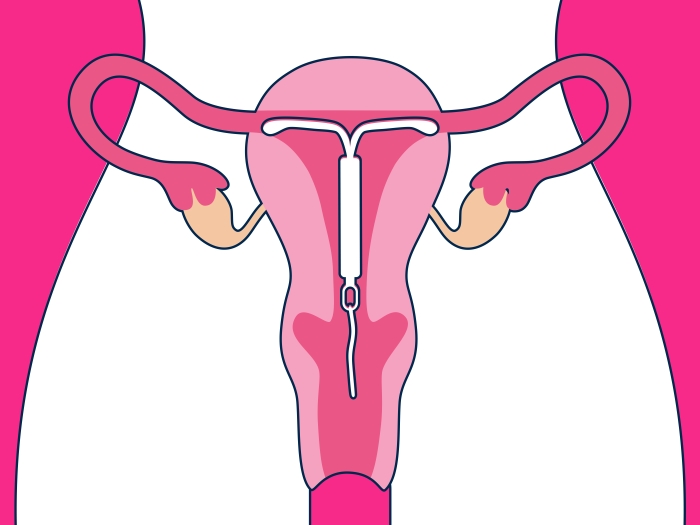Researchers examine health disparities in two of the most prevalent diseases in reproductive-aged women through a social, structural and political lens
11:30 AM
Author |

They aren’t subjects typically discussed in fibroids and endometriosis research: Stress, racism, poor diet and pollution.
But social, behavioral and environmental exposures may be important clues to help researchers understand why Black Americans have a disproportionately higher risk of developing severe fibroids than white peers, according to a new review in Fertility and Sterility.
“Studies to better understand this racial disparity have primarily been focused on biological and genetic differences but we need to dig deeper,” said senior author Erica Marsh, M.D., professor of obstetrics and gynecology at the University of Michigan Medical School and chief of the division of reproductive endocrinology and infertility at U-M Health Von Voigtlander Women's Hospital, of Michigan Medicine. “We wanted to look at health disparities in fibroids using a lens that included social, structural and political drivers.”
Marsh and colleagues conducted two separate reviews on fibroids – noncancerous tumors that grow in the uterus and can cause pain and complications – and endometriosis –an inflammatory disease associated with pelvic pain and fertility problems.
Reviews of both conditions reinforce racial disparities in prevalence, treatment and outcomes in fibroids.
There wasn’t enough data to establish any disparities in the prevalence of endometriosis, Marsh says. Studies suggest, however, that people who identify as Black face worse clinical and surgical outcomes than their white counterparts.
One of the barriers, Marsh and colleagues emphasize, is that few studies describing prevalence of the two conditions go beyond self-reporting. Because fibroids are asymptomatic in nearly half of people who have them, it could be significantly underreported, Marsh notes. Same may be true for endometriosis.
“Very little research on fibroids and endometriosis are based on the general population, making these conditions woefully understudied,” Marsh said.
“This further demonstrates that there’s been a lack of investment in two of the most two prevalent diseases in reproductive-aged women. There’s even less data on other racial and ethnic groups that are underrepresented in the medical literature.”
Research, solutions must focus on drivers of disparities
Researchers highlighted several potential factors driving disparities that warrant further research. The differences in gene expression in fibroids from Black and white people, as well as racial disparities in fibroid prevalence, they say, may reflect that Black individuals disproportionately experience exposures linked with increased risk for uterine fibroids.
This includes a higher risk of chronic psychological stress, adverse childhood experiences, perceived racism and environmental contaminant exposures like air pollution among Black individuals, which have all been associated with a higher risk for developing and experiencing severe symptoms from fibroids.
We know disparities are much more complex than genetics or individual behaviors, and we have to focus on structural and social determinates of health to better understand the disparities in diagnosis and outcomes in fibroids and endometriosis.” Erica Marsh, M.D.
Racial disparities may also stem from other social determinants of health such as a higher fat diet, lower levels of physical activity, vitamin D deficiency, as well as individual behaviors such as use of certain beauty products that contain chemicals that are associated with increased risk of uterine fibroids.
Such products may be used more among underrepresented groups to conform to predominantly white standards of beauty, such as straightened hair, Marsh notes.
“Black individuals disproportionately experience a wide range of exposures across their life course that evidence suggests lead to biological changes,” she said. “These factors may ultimately contribute to the increased incidence, prevalence, and severity of uterine fibroids among Black communities.”
Studies have also suggested racial disparities in uterine fibroids and endometriosis can be linked to a lack of adequate access to health care, authors note, including minimally invasive gynecologic surgeons, interventional radiologists, and bias and discrimination within the health care system.
“Black women may be more likely to have symptoms dismissed, report negative experiences with the health care system and wait too long to see a specialist, which delays diagnosis and treatment,” Marsh said. “These significant differences in experiences, access and dismissal or misattribution of symptoms may lead to worse outcomes.”
Impact of access to surgery
There may also be inequities in access to new surgical techniques, including minimally invasive approaches such as robotic assisted surgeries, in under resourced hospitals and communities, she adds.
Fibroids, which affect 25-40% of reproductive-aged women and more than two thirds of women by age 50, are the leading cause of hysterectomy in the United States
While some people with fibroids don't have symptoms, others have significant pain, anemia, heavy menstrual bleeding, increased urinary frequency, fertility problems and pregnancy complications.
Black individuals are diagnosed with fibroids roughly three times as frequently as white people, develop them earlier in life and tend to experience larger and more numerous fibroids that cause more severe symptoms.
Endometriosis affects an estimated one in 10 reproductive-aged women, or nearly 200 million worldwide.
The two conditions are estimated to translate to billions of dollars in healthcare costs directly and indirectly, Marsh says.
“We know disparities are much more complex than genetics or individual behaviors, and we have to focus on structural and social determinates of health to better understand the disparities in diagnosis and outcomes in fibroids and endometriosis,” Marsh said. “If we are sincere about striving for health equity, then we have to look at the underpinnings of inequity in our healthcare system and in society. Solutions need to address root causes of disparities through policy, education and programs that ensure all patients receive competent care.”
Additional authors include Jodie Katon, Ph.D., M.S., of the Veterans Administration Greater Los Angeles Healthcare System; and Torie Plowden, M.D., M.P.H., of the Walter Reed National Military Medical Center.
Study cited: “Racial Disparities in Uterine Fibroids and Endometriosis: A Systematic Review and Application of social, structural, and political context,” Fertility and Sterility. DOI: 10.1016/j.fertnstert.2023.01.02[YJ1]

Explore a variety of health care news & stories by visiting the Health Lab home page for more articles.

Department of Communication at Michigan Medicine
Want top health & research news weekly? Sign up for Health Lab’s newsletters today!





